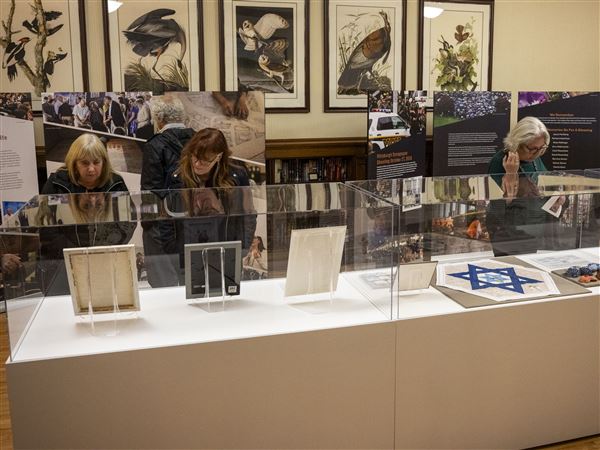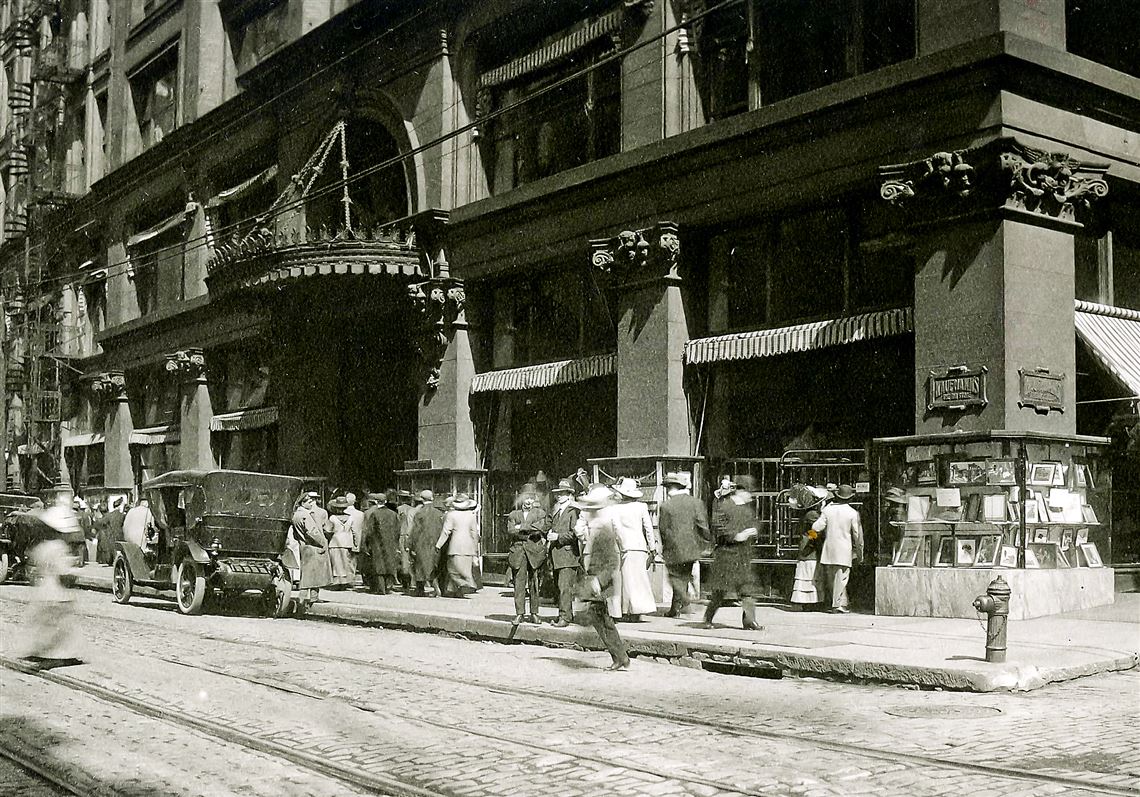The fountain sits on the mezzanine level of the Macy’s department store in Downtown Pittsburgh. It is lovely, if a bit worn and discolored.
One of three such fountains that are part of the building that served for more than a century as the flagship of the Kaufmann’s retail empire, it still sends out a stream of water when a customer toggles the handle.
Pittsburgh is in the process of saying good-bye to the grand old store that has been open longer than anyone around these days has been alive.
Since Macy’s announced this summer that it was selling the vintage, 13-floor establishment covering 1.2 million square feet, customers have been coming. They’re picking through discounted dinnerware piled on a first floor table near the former Clinique cosmetic counter, and they’re taking photos in treasured spots.
A Kaufmann’s store first arrived at the corner of Fifth Avenue and Smithfield Street in 1877. By 1879, according to an old company write-up, four Kaufmann family members and three salesmen were the whole staff.
The building kept growing, as did the sales force. The store became known as Kaufmann’s Grand Depot but it wasn’t grand enough. The late 1800s brought an addition on Fifth Avenue that took the store almost to Cherry Way. In 1913, construction spread across even more of the block.
Downtown would have other department stores but Kaufmann’s would outlast them all, even after becoming part of the May Co. in 1946 and then Macy’s in 2005.
Retail royalty
The massive building now being sold for redevelopment shows traces of its grooming under the ambitions of Pittsburgh’s merchant prince, Edgar J. Kaufmann.
Mr. Kaufmann, son of one of the four founders, was a Shady Side Academy grad who apprenticed at several retail establishments from Marshall Field’s in Chicago to Les Galeries Lafayette in Paris to a general store in Connellsville, according to Richard L. Cleary’s 1999 book, “Merchant Prince and Master Builder.”

Vintage postcard Kaufmann's Department Store (Post-Gazette Archives)
By 1913, he was basically running the store, according to Mr. Cleary’s book.
Under Mr. Kaufmann’s tenure, the staff searched the world for ideas and merchandise.
Many people have walked past the black marble panels and ornate metal work visible in the store’s vestibules, not realizing they are vestiges of costly remodeling done in late 1929 and into 1930 that involved 700 workers. It introduced reset aisles on the first floor that led to the claim of being the “world’s fastest shopping floor” because it streamlined the view of the goods, according to company literature.
A drop ceiling that was added later diluted some of the grandeur, covering the places that once held murals by the artist Boardman Robinson that showed the history of commerce. Art and culture was displayed along with the new shoes and handkerchiefs.
“Customers will come in to look at these elevators,” offered store manager Joe Hladiuk, as he rode in one of the oversized metal machines built to handle 6,000 pounds — a service for the masses that headed up to housewares or to lingerie or maybe a restaurant or salon.
Up escalators only
Sharon Mozzetti, a manager from the cosmetics department, has worked in this building for 43 years. By her recollection, thousands of people worked here when she started and those supersized elevators were well exercised by both employees and customers. And not just the elevators.
Kaufmann’s traditionally held two midnight sales every year that pulled in crowds. Management was ready.
“They would put all the escalators going in one direction because when they opened the doors, all you heard was a rumble,” Ms. Mozzetti recalled.
A number of the upper floors have been closed off for years, so the wooden Otis escalators are out of reach of casual visitors.
Also out of sight is the commercial kitchen on the 11th floor that once supplied restaurants in the building and the employee cafeteria. The kitchen still holds massive stainless steel soup pots and an ice box with a handwritten note asking people to close the door carefully.
John Carles, who got a job at the store in 1970 to help pay for college and will retire from his position as a manager when the place closes this month, has traveled to Paris and New York on buying trips. He also once feared for his life when an appearance by romance novel cover guy Fabio drew out the fan base.
He and Ms. Mozzetti have been helping sell off fixtures, reminiscing and chatting with longtime customers. Ms. Mozzetti remembers having her pre-employment physical in the company’s mini-hospital on the 10th floor. During its heyday, the store — which held both the retail operation and the administrative offices for the entire group of Kaufmann’s locations across the region — offered so many services that it became a miniature city.
“We never really even left the building,” said Ms. Mozzetti. “Everything was here until you walked out the door at night.”
Not that you couldn’t catch a glimpse of the outside world. Even after the employee cafeteria closed, Mr. Carles would go up there to spend downtime enjoying the views of Pittsburgh.
Saving history, selling the rest
Macy’s, formerly known as Federated Department Stores, bought May Co. in 2005. The Kaufmann’s name stayed until 2006 and can be still seen on several metal plaques on the exterior, along with ones carrying the new owner’s name.
Some have argued that changes made by Macy’s didn’t give shoppers enough of a reason to come to the Downtown store — not enough unique merchandise, not enough luxury items — but on this tour longtime employees emphasized that they believe the retailer is doing right by the place and its history.
Mr. Hladiuk said Macy’s contacted the Sen. John Heinz History Center in the Strip District and asked for a recommendation for someone who could help catalogue the fixtures, the paintings, the old Tic Toc menus and other things tucked away in the store.
The goal was to determine what should be sold, what should go into an archive that Macy’s keeps, and what should go to the history center in Pittsburgh. Some fixtures may turn up in boutique stores, Mr. Hladiuk said. “I was getting emails saying, ‘When are you starting your fixture sales?’”
A week or so ago, there was still a set of eight jewelry cases to be had for $2,000. Some life-sized athletic figures were tagged at between $1,500 and $2,000, including a generic Pirates player and a Steelers football player wearing Jerome Bettis’ No. 36.
Not for sale was the weighty scale that has been tucked into an alcove on the third floor as long as anyone can remember. The old scale bore evidence of its destiny — a sticker identifying it as being of historical significance.
Teresa F. Lindeman: tlindeman@post-gazette.com or 412-263-2018

Vintage image of a Kaufmann's horse and cart shows a home delivery before the days of online shopping. (Post-Gazette Archive)
Editor’s note: A caption on the first photo attached to this story had the former and current names of the street where Macy’s is located mixed up. The error was corrected. Also, the origin of an antique fountain was misattributed.
First Published: September 6, 2015, 4:00 a.m.





















